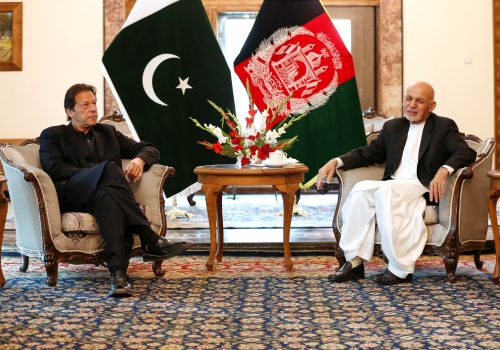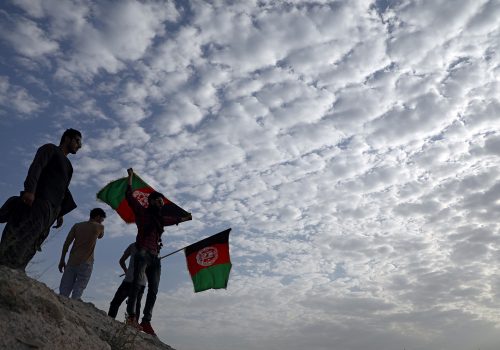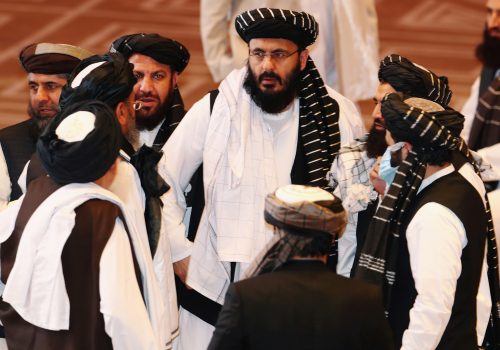Afghanistan is once again at a cross-roads facing an uncertain future. The United States, intent on ending its longest war, is hoping to withdraw its troops from Afghanistan with a timeline based on the US-Taliban agreement, now under review by the new Biden administration. Afghanistan’s neighbors, hedging their bets and securing their borders, are expecting that the ensuing chaos will help to ensure that their geopolitical interests are served via proxies or at least a friendly government in Kabul. Meanwhile, Afghan political and military elites are sensing the shift in the political landscape and reconfiguring their loyalties and political alignments with regional actors and beyond. This is clearly evident from the recent Taliban delegation visits to Russia, Iran, and other countries, which is being counterweighted by President Ghani’s phone call diplomacy with world leaders and his Foreign Minister’s shuttle diplomacy to various regional capitals. We have also seen a plethora of Afghan strongmen and former officials visiting Pakistan, India, and other regional powers, effectively showing that all the Afghan sides are vying for regional and global support for their end and share in the Afghan war and peace game plan. Such sporadic, multi-vector diplomacy by all Afghan parties will only pave the way for further regional interference in the internal affairs of Afghanistan under the pretext of regional consensus building through preserving their legitimate interests in Afghanistan.
If history is any guide, a win-win strategy for both Afghanistan and the region in the event of a full withdrawal of US-NATO forces would be to invest in a neutral, stable, and friendly Afghan government which is inclusive, broad based, a friend to all, and a threat to none. This could be achieved if the three inter-related consensuses—national, regional, and global—are built on a minimum set of criteria that are acceptable to all, namely, peace and stability for Afghans, guarantees that the Afghan soil is not used by any force to destabilize Afghanistan’s neighbors and the region, and a counter-terrorism plan led by western powers that will ensure that global and regional terror groups do not regain a foothold in Afghanistan. There is no doubt that an unstable Afghanistan, at war with itself and home to global terrorism, would result in spillover effects—increased terrorism, a large number of refugees, and increased drug trafficking to name a few—that would far outweigh the geopolitical benefits that such a future might bring to regional players.
On the regional level, this means that the sustainability and long-term success of any Afghan peace deal will require a regional consensus based on clearly defined “redlines,” including a commitment by all regional players to cease political-military support to all the parties of the Afghan conflict and to put their weight behind a strong, inclusive, and broad-based government that represents the aspirations and hopes of the Afghan people and, importantly, is not a threat to its neighbors and the world at large. This will not be easy to achieve. Historically, Afghan wars have never been solely and purely civil wars. They have always involved some level of foreign sponsorship—mostly from regional countries—for warring internal actors, with each party using each other for their own ends. This is largely due to Afghanistan’s geography and belligerent neighbors, many of which only view Afghanistan as a liability, a source of instability, or simply as a bridge to Central and South Asia. Very few of its neighbors view Afghanistan as a potential partner or asset to the region. Collaboration is not impossible, however. While it is true that in the past regional divergences of interests have fostered proxy wars, convergence of regional interests has also led to stability and increased connectivity, trade and commerce.
An old game with new players: The return of great power politics and proxy wars
In the late 19th century, Lord George Curzon observed that Afghanistan was, at its origin, an empty space on the map, which was neither Persian, Russian, nor British. To this day, despite the objections of many Afghan scholars, many consider Afghanistan as a “regional country,” little more than a geopolitical compression zone at the intersection point of the regional security architectures of Russia, Iran, and India. Indeed, it is one of the few countries in the world whose fate is so intertwined with the actions, interactions, and reactions of its neighbors that it can barely be said to have any independence of its own.
Today, the ghosts of “The Great Game,” as the 19th century political confrontation between the British Empire and the Russian Czar vying for influence over Central and South Asia was known, are present with a larger set of regional players.
For the past two decades, Afghanistan’s six near neighboring countries—Pakistan, Iran, Tajikistan, Turkmenistan, Uzbekistan, and China—and three far neighbors—Russia, India, and Turkey—have viewed the American military presence in Afghanistan as a mixed blessing. On the one hand, the United States has been fighting the global and regional terror groups that pose serious security threats. On the other hand, the long-term presence of the United States and NATO in Afghanistan was seen as a nefarious scheme designed for geopolitical games. Today, these countries are in the process of adjusting their diplomatic and security postures towards Afghanistan in preparation for the eminent withdrawal of US forces from the country.
Change is underway as each player defines its approach. The Central Asian states, for example, are heavily influenced by Moscow which, like the Indians, have followed a dual policy of supporting the Afghan state but also pushing for a political settlement between the Afghan government and the Taliban, while at the same time moving to re-establish old ties with their proxy allies inside Afghanistan. Pakistan and Iran have been pursuing a complex multilayered policy of supporting proxies but at the same time maintaining cordial relations with Kabul and its international backers. China, for its part, continues to view the country through a limited security lens and has been merely an observer of Afghan affairs, often closely aligning itself with Pakistan, while more recently, countries like Uzbekistan and Turkmenistan have been viable economic and trade partners of Afghanistan.
At least three set of political games are being played on the board. The Americans, along with the Pakistanis, are hoping to convince a major part of the Southern Taliban to give up fighting and become a dominant group in any future government, effectively taking the brand name and address of the Taliban and merging them within the established post-September 11 political order in Afghanistan. The Iranians, Indians, and Russians intend to counter balance the Americans, and do not agree with their approach to peace and withdrawal because they see the ongoing peace talks as too much of an Americanized peace deal with little consultation with them, often terming it as a withdrawal plan. That said, they have consistently maintained their own contacts and consultations with the Taliban on the Afghan peace process and called for a responsible withdrawal of foreign forces from Afghanistan. The Europeans have thus far pursued a principled approach, following a policy of supporting the Afghan government and the Republic in Afghanistan, while pushing for a political settlement with the Taliban. A few European countries have, on a bilateral basis, sided with the American approach to end the war in the country as early as possible.
On the ground, despite the enlarged number of players, there is a sense of history repeating itself as a familiar script is being played out on the streets of Kabul and in the villages of rural Afghanistan. Another great power, this time the United States, is on its way out, and Afghans must prepare to adapt to a new normal, re-aligning their loyalties, and reimagining their standards of living as this reality draws near. As the international community reduces its economic aid and presence, the Afghan government’s authority and ability to govern are diminishing as the areas under its control shrink. In the power vacuum left by the shrinking government, the Taliban, local strongmen, and militias are slowly increasing their footprints. Moreover, in the absence of a strong Afghan government, we can already observe regional players swooping in, eager to re-establish old ties with their proxies, ready to step into the chaos that likely ensue following a US withdrawal. These are the signs of the coming collapse if not managed properly by both the Afghan Government and the international community.
The road ahead for the region and Afghanistan: A bumpy ride
The Afghan peace chessboard has now been laid out. Two potential outcomes are visible at this stage depending on how the US withdrawal is carried out and how Afghanistan’s neighbors respond to the ensuing power vacuum: relative stability or a Syrian style civil war.
So far, to address these regional woes, the Afghan government and its allies have resorted to a plethora of regional diplomatic and security mechanisms. These days, the diplomatic and security community in Kabul is awash with buzzwords, processes, and groups such as “regional consensus,” “International Support Group,” “Heart of Asia,” “Istanbul Process,” and “6+2 Regional Peace Format,” among others. Although some of these platforms have existed for many years, there is little show for these efforts beyond lists of meetings and photo-op conferences, some resulting in statements, declarations, and papers that have done little to change the harsh realities of the Afghan conflict. As the war rages on—gaining momentum and bringing death and destruction to Afghanistan—the legitimacy and credibility of many of these mechanisms and platforms have been severely damaged in the eyes of the Afghan public and regional security actors who have come to regard them as little more than an exercise in public relations. It is easy to see why the Taliban and other groups readily ignore the statements and declarations arising from these platforms, which are unable to impose diplomatic or military costs on their non-compliance. For these groups, it is battlefield realpolitik.
If the pathway to stability for Afghanistan lies with the region and Asia, another approach is needed. The following steps are required to forge a regional consensus on the minimum set of principles and commitments for peace and stability in Afghanistan:
- A commitment by Afghanistan’s neighbors and other regional actors to support an inclusive and broad-based central government in Afghanistan through a regional peace diplomacy strategy;
- A verifiable commitment, with the necessary oversight, from neighboring and regional security actors to stop supporting and cut their tactical political-military ties with proxy groups inside Afghanistan;
- A signed agreement of good neighborly relations that declares Afghanistan as a neutral state;
- The creation of three important but interlinked platforms:
- A peace alliance and cooperation platform for the US-NATO and six of Afghanistan’s neighbors – this will be a single platform for US and Afghan neighbors to work on peace and coordinate withdrawal of forces so as no vacuum is left behind;
- A single regional platform dedicated to Afghan peace and security consisting of the six countries neighboring Afghanistan plus the three far neighbors, i.e., India, Turkey, and Saudi Arabia – this will be a platform for Afghanistan’s far neighbors to forge peace and coordinate security matters related to Afghanistan;
- A single cooperation platform consisting of the United Nations and regional countries dedicated to peace and humanitarian assistance.
Conclusion
As history has clearly shown, the region has a lot to gain, or lose, from what happens to Afghanistan. A continuation of the Afghan war in whatever form it may take will not stay contained to Afghanistan and will likely spread and engulf the entire region in the globalized world. A zero-sum approach to the Afghan conflict by regional countries will only further the suffering of Afghans while blocking regional progress and development through its spill-over effects. Furthermore, a policy of containment will also not work, and extra-regional security providers will be less likely to get involved in the Afghan dilemma once they have left the country and the region. South Asia will then be left to deal with the “Afghan problem” on their own. At this crossroad, through their influence and leverage on Afghan groups, regional stakeholders have the power to help forge peace. The time is thus ripe for Afghanistan’s neighboring states to work together and collectively prevent further chaos.
Tamim Asey is the founder and executive chairman of the Institute of War and Peace Studies in Kabul, Afghanistan, the former Afghan deputy minister of defense, and an expert adviser on the Atlantic Council’s Strategic Dialogues on Afghanistan.

The South Asia Center is the hub for the Atlantic Council’s analysis of the political, social, geographical, and cultural diversity of the region. At the intersection of South Asia and its geopolitics, SAC cultivates dialogue to shape policy and forge ties between the region and the global community.
Related content
Image: The author receiving Pakistan’s Chief of Army Staff (COAS) General Qamar Javid Bajwa along with ISI DG Lt. General Naveed Mukhtar at the Ministry of Defense HQ helipad in Kabul in 2017.



